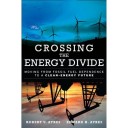 During my daily hours of commute I have been reading for the past two weeks Crossing the Energy Divide by Robert and Edward Ayres. The thesis defended by the authors is simple :
During my daily hours of commute I have been reading for the past two weeks Crossing the Energy Divide by Robert and Edward Ayres. The thesis defended by the authors is simple :
Between the world of today with an economy relying on fossil fuels and the world of tomorrow relying only on clean and low carbon energy sources, massive investments in energy efficiency are required.
These investments will be able to bridge the gap, the chasm, between these two worlds. This book brings many more ideas and figures.
We have seen here that energy efficiency is the best solution for our energy and climate problems. Crossing the Energy Divide presents three main objectives :
- Massive reduction of greenhouse emissions at negative or very low net cost ;
- Energy independence without drilling for oil off the California or Florida coasts ;
- Greatly improved energy security
There are eight girders of the energy transition bridge, each one being tackled extensively :
- Recycling waste-energy stream : The book starts with a compelling example of two factories recovering waste heat to generate 190 MW of low carbon electricity. The potential for such systems in the United States alone is about 100 GW of capacity, up to ten percent of the electricity capacity ;
- Utilizing combined heat and power (CHP) : Current electric plants have an efficiency of around 33 percent. By capturing and using that heat for houses and buildings nearby, we could reach an efficiency of 50 tio 80 percent. The potential for the United States alone is of 135 GW.
- Increasing energy efficiency in industrial processes and buildings. As we have seen in countless occasions in this blog, energy efficiency – or negawatts – have a huge potential. For buildings, you may read extracts of my own Master’s thesis on the residential sector in France.
- Increasing energy efficiency in consumer end uses. A future example of this would be the energy efficient air conditioning system I blogged about this summer. There again, the potential is huge.
- Kick-starting the micropower revolution, or “rooftop” revolution. Producing your own electricity is possible with the rise of solar photovoltaïc, which provides several advantages over centralized solutions like burning fossil fuels.
- Substituting energy services for products. People do not need gasoline, they need mobility ; similarly they do not need fuel, they need heat for their houses.
- Redesigning buildings and cities for climate change. Cities in coastal areas – accounting for a large share of the global population – will be under serious threat as seal level rises because of climate change. This is why rebuilding them is important. See these articles for more on rising sea levels.
- Reforming fresh-water management strategies. Water is critical to the survival of Mankind, luckily solutions exist to avoid increasing scarcity problems;
—
Conclusion : I consider Crossing the Energy Divide as a real must read and an eye opener as it brings many details on lesser talked about solutions and their huge potential.
I knew that solving what I call the climate energy equation was not a problem of technology but of political willingness to apply them and Robert and Edward Ayres convinced me even more.
Grade : 19/20.

Pingback: The huge benefits of decentralizing utilities :: Sustainable development and much more
Pingback: District Heating and Cooling Has Huge Potential - CleanTechies